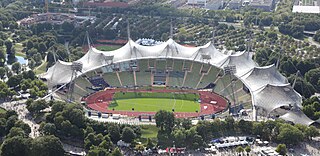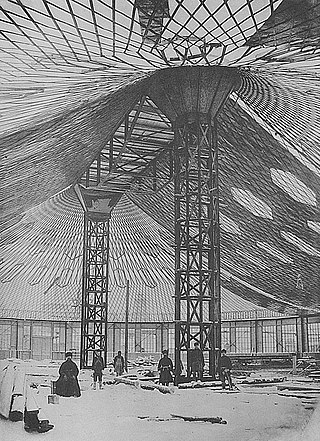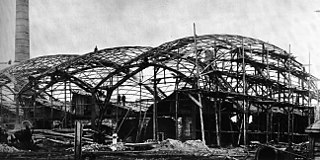
An umbrella or parasol is a folding canopy supported by wooden or metal ribs that is mounted on a wooden, metal, or plastic pole. It is usually designed to protect a person against rain. The term umbrella is traditionally used when protecting oneself from rain, while parasol is used when protecting oneself from sunlight, though the terms continue to be used interchangeably. Often the difference is the material used for the canopy; some parasols are not waterproof, and some umbrellas are transparent. Umbrella canopies may be made of fabric or flexible plastic. There are also combinations of parasol and umbrella that are called en-tout-cas.

The Prophet's Mosque is the second mosque built by the Islamic prophet Muhammad in Medina, after that of Quba, as well as the second largest mosque and holiest site in Islam, after the Masjid al-Haram in Mecca, in the Saudi region of the Hejaz. The mosque is located at the heart of Medina, and is a major site of pilgrimage that falls under the purview of the Custodian of the Two Holy Mosques.

The Quba Mosque is a mosque located in Medina, in the Hejaz region of Saudi Arabia, built in the lifetime of the Islamic prophet Muhammad in the 7th century C.E. It is thought to be the first mosque in the world, built on the first day of Muhammad's emigration to Medina. Its first stone is said to have been laid by the prophet, and the structure completed by his companions. The mosque was subsequently modified across the centuries until the 1980s, when it was completely replaced by a new building that stands today.
Expo 2000 was a World Expo held in Hanover, Germany from 1 June to 31 October 2000. It was located on the Hanover Fairground, which is the largest exhibition ground in the world. Initially, some 40 million people were expected to attend the exhibition over the course of months; however, eventually with less than half of this number, the Expo was a flop and turned out to be a financial failure.

Olympiastadion is a stadium located in Munich, Germany. Situated at the heart of the Olympiapark München in northern Munich, the stadium was built as the main venue for the 1972 Summer Olympics.

In structural engineering, a tensile structure is a construction of elements carrying only tension and no compression or bending. The term tensile should not be confused with tensegrity, which is a structural form with both tension and compression elements. Tensile structures are the most common type of thin-shell structures.
Horst Berger (1928-2019) was a structural engineer and designer known for his work with lightweight tensile architecture. After receiving a degree in Civil Engineering in 1954 from Stuttgart University in Stuttgart, Germany, he began working in 1955 at the Bridge and Special Structures Department of Wayss and Freitag in Frankfurt. In 1960, he joined Severud Associates in New York city and worked on projects such as the St. Louis Arch, Madison Square Garden, and Toronto City Hall.
Frei Paul Otto was a German architect and structural engineer noted for his use of lightweight structures, in particular tensile and membrane structures, including the roof of the Olympic Stadium in Munich for the 1972 Summer Olympics.

The Metropolitan Life Insurance Company Tower is a skyscraper occupying a full block in the Flatiron District of Manhattan in New York City. The building is composed of two sections: a 700-foot-tall (210 m) tower at the northwest corner of the block, at Madison Avenue and 24th Street, and a shorter east wing occupying the remainder of the block bounded by Madison Avenue, Park Avenue South, 23rd Street, and 24th Street. The South Building, along with the North Building directly across 24th Street, comprises the Metropolitan Home Office Complex, which originally served as the headquarters of the Metropolitan Life Insurance Company.

The Clock Towers, is a government-owned complex of seven skyscraper hotels in Mecca, Saudi Arabia. These towers are a part of the King Abdulaziz Endowment Project that aims to modernize the city in catering to its pilgrims. The central hotel tower, which is the Makkah Clock Royal Tower, is the fourth-tallest building and sixth-tallest freestanding structure in the world. The clock tower contains the Clock Tower Museum that occupies the top four floors of the tower.
The year 2006 in architecture involved some significant architectural events and new buildings.

The architecture of Kansas City encompasses the metropolitan area, anchored by Kansas City, Missouri (KCMO). Major buildings by some of the world's most distinguished architects and firms include McKim, Mead and White; Jarvis Hunt; Wight and Wight; Graham, Anderson, Probst and White; Hoit, Price & Barnes; Frank Lloyd Wright; the Office of Mies van der Rohe; Barry Byrne; Edward Larrabee Barnes; Harry Weese; and Skidmore, Owings & Merrill.

Schlaich Bergermann Partner is a nationally and internationally active structural engineering and consulting firm with headquarters in Stuttgart, Germany and branch offices in Berlin, New York City, São Paulo, Shanghai and Paris.

Werner Sobek is a German architect and structural engineer.
Buro Happold Limited is a British professional services firm that provides engineering consultancy, design, planning, project management, and consulting services for buildings, infrastructure, and the environment. It was founded in Bath, Somerset, in 1976 by Sir Edmund Happold when he took up a post at the University of Bath as Professor of Architecture and Engineering Design.

A gridshell is a structure which derives its strength from its double curvature, but is constructed of a grid or lattice.

Istanbul Sapphire, or Sapphire, is a skyscraper located in the central business district of Levent in Istanbul, Turkey.
Lilo Rasch-Naegele was a German painter, graphic artist, fashion designer and book illustrator. Her extensive work left a distinct mark on the artistic landscape of Stuttgart.
Mahmoud Bodo Rasch is a German architect who specializes in the construction of large convertible umbrellas and lightweight structures. He is founder and owner of SL Rasch GmbH Special and Lightweight Structures with branches in Leinfelden-Echterdingen, Jeddah, Mecca and Medina.

Medina Haram Piazza Shading Umbrellas or Al-Masjid An-Nabawi Umbrellas are convertible umbrellas erected at the piazza of Al-Masjid an-Nabawi in Medina, Saudi Arabia. The shade of each umbrella is extended in the four corners, with a total area covered of 143,000 square meters. These umbrellas are aimed to protect worshipers from the heat of the sun during prayer, as well as from the risk of slipping and falling in the event of rain. Similar structures are built at the square of the mosques worldwide. At Al-Masjid An-Nabawi, there are a total of 250 umbrellas.












